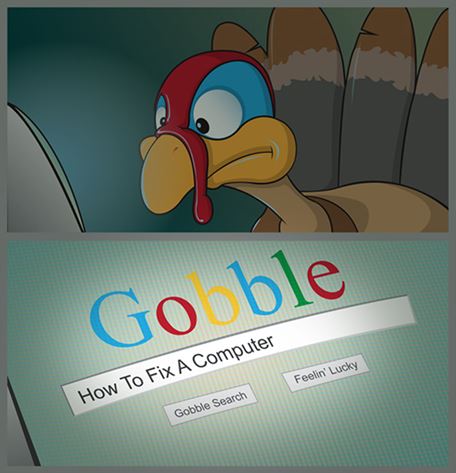November 2013

Who Else Wants To Win A $50 Gift Card?

What is the most expensive object ever constructed?
The correct answer was b) The International Space Station.
Now, here’s this month’s trivia question. The winner will receive a gift card to BEST BUY!
What year did the Dallas Cowboys begin playing their traditional Thanksgiving Day game:
a) 1958
b) 1963
c) 1966
d) 1970
Call us right now with your answer!
214-329-1349
3 “Techie” Reasons You Can Be Thankful This Season
- Cyber Thieves Keep A-Knockin’ But They Can’t Come In. A study presented at the International Conference on Dependable Systems and Networks showed that small-business networks are attacked every 39 seconds by some type of hacker or malicious software. Thankfully, having the proper firewall and office network security tools can prevent even the most determined cyber hacker from getting his hands on your network.
- Downtime Should Be A Thing Of The Past. Thanks to monitoring and maintenance tools that are openly available, any reputable computer company can now actually notice when things go awry and prevent your computers from having issues. Hot fixes, patches and security updates are generally items that, when maintained on a regular basis, keep a network healthy and up and running. If, for some reason, your network still has some kind of downtime, cloud-based remote management tools allow your IT professional to access your system from anywhere, getting you up and running more quickly than ever before.
- If Disaster Strikes, You Can Be Back Up & Running In Minutes Instead Of Days. In addition to lost data, many businesses’ operations would be completely down for days or weeks if a major disaster like fire, flood or theft ever occurred. Here’s where Backup & Disaster Recovery solutions (BDR) can help you feel very thankful indeed. Most of today’s BDR solutions include a “virtualization” component, which means an exact “picture” of your server and computers is taken throughout the day and stored elsewhere. If you ever need to get back up and running, your IT company simply restores that image…and you’re back in business.
Want to feel thankful instead of frustrated with your computers? Call us before November 30 for a FREE Problem Prevention Network Audit (a $300 value) that will help eliminate problems on your network and give you peace of mind.
CALL 214-329-1349 NOW!

7 IT Policies And Procedures That Companies Under HIPAA Regulations Must Have
HIPAA and HITECH have been around for quite some time. Even so, many companies covered by these laws are way behind the times when it comes to actual implementation. And when you really think about it, even companies not covered by these laws should have the requisite policies and procedures in place.
- Access Control Policy. How are users granted access to programs, client data and equipment? Also includes how administrators are notified to disable accounts when needed.
- Workstation Use Policy. Requiring secure passwords, monitoring logins and limiting unsuccessful logins are just a few of the basics covered. Policies also need to cover basic security best practices such as not allowing passwords to be written down or shared with others.
- Security Awareness Training. Organizations must ensure regular training of employees regarding security updates and what to be aware of. You must also keep an audit trail of your reminders and communications in case you’re audited.
- Malicious Software Controls. You must have documented policies for the frequency with which anti-malware and antivirus software are updated and what happens if an infection/outbreak occurs.
- Disaster Recovery Plan. How you respond to emergency situations (of all shapes and sizes) must be fully documented and tested regularly. A full Disaster Recovery Plan is something our company can help you with.
- Media Disposal Policy. How do you dispose of old computer equipment and data? You must have policies and procedures in place that cover exactly how all equipment is properly disposed of and logged.
- Review And Audit Procedures. There’s much more to HIPAA compliance than the 6 items discussed here; however, be certain also that whatever you do has a firm audit trail/log that shows that everything has been executed according to plan.
These are just starting points. If you’re subject to HIPAA or just want to make sure that your company is covered by these simple best practices, contact our office and we’ll be happy to review these areas with you.
Client Spotlight: Dr. Elizabeth Eversull at Pure Healing

Shiny New Gadget: Leap Motion Controller

Just when you thought technology couldn’t make things any easier, they’ve gone and done it again! With a wave of a hand or lift of a finger, you’re about to use your computer in a whole new way. The Leap Motion Controller senses the way you naturally move your hands. So you can point, wave, reach and grab. Even pick something up and put it down. Just like in real life. It’s an amazing device for the things you do every day and for the things you never thought you could do.
- Browse the web, read articles, flip through photos and play music just by lifting a finger.
- Draw, paint and design with your fingertip. You can even use a real pencil or paintbrush.
- Sculpt, mold, stretch and bend 3D objects. Take things apart and put them back together.
- Pick, pluck, strum and drum. Play air guitar, air harp or air anything.
- Slice fruit and shoot bad guys with your finger.
You literally hold all the power in your fingertips. This sensitive device provides superb accuracy up to 1/100th of a millimeter. Get yours today for just $79.99. https://www.leapmotion.com/product
Solid Strategies = Solid Success
Success results from a solid strategy. Even the greatest ideas are of little value unless they are backed up by a practical and workable plan of action. The word strategy comes from an ancient Greek term that literally means to be a general, leading troops into battle. Setting up a good strategic plan involves five steps:
The first step is to translate your vision into measurable and achievable goals.
You decide specifically what you want to accomplish during the next five to ten years — those are your long-range goals. Next, you break those goals down into intermediate goals — things you wish to accomplish during the next six months or year. Then you break them down further into short-term goals covering the next month or six weeks.
The second step is to break your goals down into achievable objectives.
Dr. Robert Schuller says, “Yard by yard life is hard, inch by inch it’s a cinch.” Working by objectives helps you concentrate on what’s important, instead of spinning your wheels on those things that seem urgent but don’t lead to your long-term goals. Objectives add purpose and direction to all your activities.
The third step is to set up your strategies for accomplishing your objectives.
Strategies are the specific ways you will go about achieving your objectives. The more clearly thought-out they are, the more effective they will be.
Fourth, you choose each task you must complete each day to achieve your goals.
This is where most planning breaks down. We tend to leave it vague — thinking that, as long as we are working hard all the time, we are achieving our goals. Most people I talk with are extremely busy — and most of them are working hard to do things right. The problem is they are not doing enough of the right things — the things that will help them achieve their goals.
It is not enough to merely list each task you need to do; you need to build the tasks into your schedule. So many hours each day should be dedicated to working on specific actions that will lead to accomplishing your definite objectives.
And, finally, build in the monitoring mechanisms that will help you keep track of your progress toward implementing your plan.
It’s one thing to have a “gut-level feeling” that you must be doing something right because you are always working hard. But it is far better to design simple mechanisms to let you know precisely how much progress you are making.
Look for a few key indicators that will help you stay on track, and monitor those like a doctor would monitor the vital signs of a patient. It doesn’t matter how much activity is going on. What matters is how successful you are in achieving your objectives.
One good example would be that you would target to contact three people each day to generate new business. At the end of the day, you’d know whether you have achieved that goal. Your plan is not complete until it has been communicated satisfactorily to every person in your organization who must help to implement it.
Would You Rather Text Than Talk? Essential Tips For Business Texting
You use your iPhone or Android for everything else. Your spouse even texts you to grab some milk at the store or to tell you they’ll be gone when you get home. It’s quick, easy and gets the job done. Why not in business too?
If you’re going to text for business purposes, follow these 7 texting tips to keep it professional:
- Consider if your message is urgent. Your text may interrupt your recipient…be sure there’s a good reason for that interruption.
- Is e-mail better? Most people prefer business communications via e-mail as it better respects their time and ability to respond appropriately. Text messages are also easily lost if sent at a bad time.
- Do they only e-mail you? If yes, respond to them in the same way. If they e-mail, send an e-mail. If they call, call them back.
- DON’T TYPE IN ALL CAPS. DON’T YOU FEEL LIKE SOMEONE IS YELLING AT YOU WHEN THEY TYPE IN ALL CAPS? DON’T SEND E-MAILS OR TEXTS IN ALL CAPS.
- Proofread your message. Ever hear of “Auto-Correct” in text messages? Some can be downright embarrassing. If you’re taking the time to write the message, take the extra seconds to proofread.
- No abbreviations! Your recipient shouldn’t have to decipher your text message with a decoder ring. Be as clear as you can with proper grammar and pronunciation. No sense in risking losing a client who gets fed up with your messages.
- Include your name in the message. Not everyone knows who you are simply by your cellphone number. Assume that the person doesn’t know who the message is coming from.
If you do text in a business environment, especially with a client or prospect, follow these 7 tips to ensure that you are perceived as the true business professional that you are!
The Lighter Side: Random Aviation Facts
November is National Aviation History Month. So to celebrate, here are some random aviation facts that you will likely find interesting:
- A Boeing 737 weighing 150,000 pounds (68,000 kilograms) must deflect about 88,000 pounds (40,000 kg) of air — over a million cubic feet (31,500 cubic meters) down by 55 feet (16.75 meters) each second while in flight.
- A commercial aircraft door will not open in flight because it is actually bigger than the window frame itself, and the door opens inward toward the cabin. To open, it must be opened inward, rotated and then slipped sideways out of the frame. Even if the door could somehow be opened, it would be like lifting a 2,200-pound (1,000-kilogram) weight.
- Most planes flying internationally have their home country’s flag painted on or around their tails. Generally, the flag is facing the proper way round on the left (port) side of the aircraft and backward on the right (starboard) side. Why? Because that’s how it would look if a real flag were hoisted on a pole above the airplane during the flight.
- Airline doors and windows are often inset a few millimeters from the fuselage so that they’ll expand to be flush with the fuselage during flight.
- The windows in an airport control tower must be tilted out at exactly 15 degrees from the vertical to minimize reflections from both inside and outside the control tower.



